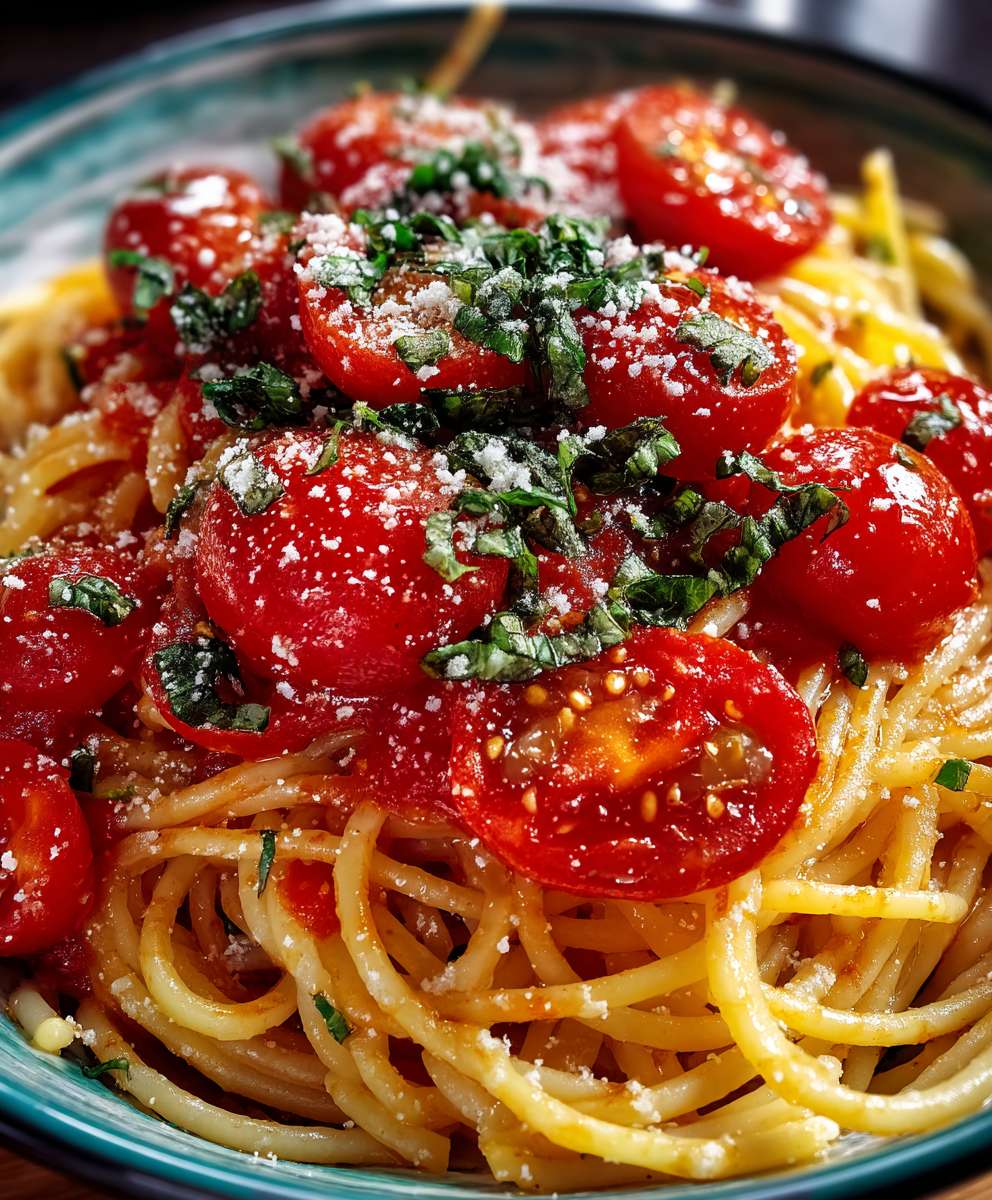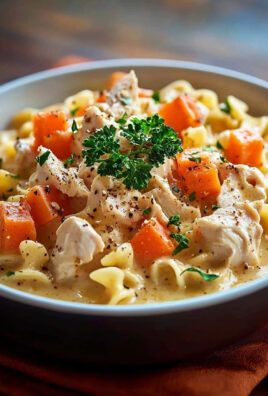Pasta al Pomodoro, a dish so simple, yet so profoundly satisfying, is a cornerstone of Italian cuisine. Have you ever craved a meal that’s both comforting and bursting with fresh, vibrant flavors? This is it. Imagine twirling perfectly cooked pasta, coated in a luscious, homemade tomato sauce, fragrant with basil and garlic. It’s a culinary hug in a bowl!
The beauty of Pasta al Pomodoro lies in its humble origins. Born from the resourcefulness of Italian cooks, it showcases the incredible potential of fresh, seasonal ingredients. While the exact origins are debated, it’s widely believed to have emerged in the Naples region, where tomatoes first gained popularity in Italian cooking. It’s a testament to the Italian philosophy of “less is more,” proving that the simplest dishes can often be the most delicious.
People adore Pasta al Pomodoro for its bright, clean taste and its incredible versatility. The sweetness of the tomatoes, balanced by the acidity and aromatic herbs, creates a symphony of flavors that dance on your palate. Plus, it’s incredibly quick and easy to prepare, making it a perfect weeknight meal. Whether you’re a seasoned chef or a kitchen novice, you can whip up a batch of this classic dish in no time. The satisfying texture of perfectly cooked pasta, combined with the smooth, flavorful sauce, makes it a guaranteed crowd-pleaser. Get ready to experience the magic of authentic Italian cooking!
Ingredients:
- 1 pound spaghetti (or your favorite pasta shape)
- 2 tablespoons olive oil, extra virgin
- 4 cloves garlic, minced
- 1/2 teaspoon red pepper flakes (optional, for a little kick!)
- 1 (28 ounce) can crushed tomatoes
- 1 (15 ounce) can tomato sauce
- 1/2 cup fresh basil leaves, chopped, plus more for garnish
- 1 teaspoon dried oregano
- 1/2 teaspoon sugar (to balance the acidity)
- Salt and freshly ground black pepper to taste
- 1/4 cup grated Parmesan cheese, plus more for serving
- 1/4 cup reserved pasta water (important!)
Preparing the Sauce: The Heart of the Pomodoro
Okay, let’s get started on the sauce! This is where the magic happens. A good Pomodoro sauce is all about simple, fresh ingredients and letting them simmer together to create a rich, flavorful base.
- Sauté the Garlic: In a large pot or Dutch oven, heat the olive oil over medium heat. Add the minced garlic and red pepper flakes (if using). Sauté for about 1-2 minutes, or until the garlic is fragrant and lightly golden. Be careful not to burn the garlic, as it will become bitter. Burnt garlic can ruin the whole sauce, so keep a close eye on it! I like to stir it constantly during this step.
- Add the Tomatoes: Pour in the crushed tomatoes and tomato sauce. Stir well to combine. The combination of crushed tomatoes and tomato sauce gives the sauce a great texture not too chunky, not too smooth.
- Season and Simmer: Add the chopped basil, dried oregano, sugar, salt, and pepper. Stir everything together. Bring the sauce to a simmer, then reduce the heat to low, cover, and let it simmer for at least 30 minutes, or up to an hour. The longer it simmers, the more the flavors will meld together and the richer the sauce will become. I usually give it a stir every 10-15 minutes to prevent it from sticking to the bottom of the pot. During this simmering time, you can prepare the pasta.
- Taste and Adjust: After simmering, taste the sauce and adjust the seasoning as needed. You might want to add a little more salt, pepper, or sugar, depending on your preference. Remember, everyone’s taste buds are different!
Cooking the Pasta: Al Dente Perfection
While the sauce is simmering, let’s get the pasta cooking. The key to great pasta is cooking it “al dente,” which means “to the tooth” in Italian. It should be firm and slightly chewy, not mushy.
- Boil the Water: Fill a large pot with plenty of water (at least 6 quarts). Add a generous amount of salt about 1-2 tablespoons. The salt not only seasons the pasta but also helps it cook properly. Bring the water to a rolling boil. A rolling boil is crucial for even cooking.
- Add the Pasta: Once the water is boiling, add the spaghetti. Stir immediately to prevent the pasta from sticking together.
- Cook Al Dente: Cook the pasta according to the package directions, usually around 8-10 minutes, or until it’s al dente. Start checking for doneness a minute or two before the recommended time. The best way to check is to fish out a strand of pasta and taste it. It should be firm to the bite but not hard or crunchy.
- Reserve Pasta Water: Before draining the pasta, reserve about 1/4 cup of the pasta water. This starchy water is liquid gold! It will help to bind the sauce to the pasta and create a creamy, emulsified sauce. I usually use a measuring cup to scoop out the water before draining.
- Drain the Pasta: Drain the pasta in a colander. Do not rinse the pasta unless you are making a cold pasta salad. Rinsing removes the starch, which we want to help the sauce cling to the pasta.
Bringing it All Together: The Grand Finale
Now for the best part combining the sauce and pasta! This is where the magic really happens, and you’ll see how the reserved pasta water transforms the sauce.
- Combine Sauce and Pasta: Add the drained pasta to the pot with the sauce. Toss well to coat the pasta evenly with the sauce.
- Add Pasta Water: Add the reserved pasta water to the pot. Toss again to combine. The pasta water will help to create a creamy, emulsified sauce that clings beautifully to the pasta. If the sauce seems too thick, add a little more pasta water until it reaches your desired consistency.
- Add Parmesan Cheese: Stir in the grated Parmesan cheese. The cheese will melt into the sauce, adding richness and flavor.
- Serve Immediately: Serve the pasta immediately, garnished with fresh basil leaves and extra Parmesan cheese. A drizzle of extra virgin olive oil on top is also a nice touch.
Tips and Variations: Making it Your Own
This Pasta al Pomodoro recipe is a classic, but there are plenty of ways to customize it to your liking. Here are a few ideas:
- Add Vegetables: Sauté some chopped onions, bell peppers, or zucchini along with the garlic for extra flavor and nutrients.
- Spice it Up: Add more red pepper flakes or a pinch of cayenne pepper for a spicier sauce.
- Make it Creamy: Stir in a dollop of heavy cream or mascarpone cheese at the end for a richer, creamier sauce.
- Add Meat: Brown some ground beef, Italian sausage, or pancetta and add it to the sauce for a heartier meal.
- Use Different Herbs: Experiment with different herbs, such as thyme, rosemary, or parsley.
- Roast the Tomatoes: For an even deeper flavor, roast the tomatoes in the oven before making the sauce. Toss them with olive oil, garlic, and herbs, and roast at 400°F (200°C) for about 30-40 minutes.
- Fresh Tomatoes: If you have access to fresh, ripe tomatoes, you can use them instead of canned tomatoes. Peel and chop about 2 pounds of fresh tomatoes and simmer them in the sauce. You may need to simmer the sauce for a longer time to reduce the liquid.
Serving Suggestions: Completing the Meal
Pasta al Pomodoro is delicious on its own, but it’s even better when served with a few complementary dishes.
- Garlic Bread: A classic pairing! Serve with crusty garlic bread for soaking up the delicious sauce.
- Salad: A simple green salad with a vinaigrette dressing is a refreshing contrast to the rich pasta.
- Grilled Vegetables: Grilled zucchini, eggplant, or bell peppers are a healthy and flavorful side dish.
- Meatballs: Serve with homemade or store-bought meatballs for a heartier meal.
- Wine: A light-bodied red wine, such as Chianti or Pinot Noir, pairs well with Pasta al Pomodoro.
Storage and Reheating: Enjoying Leftovers
Pasta al Pomodoro is even better the next day! Store leftovers in an airtight container in the refrigerator for up to 3 days.
To reheat, simply microwave the pasta until heated through, or reheat it in a saucepan over medium heat. You may need to add a little water or broth to prevent it from drying out. You can also add a little fresh basil and Parmesan cheese before serving.
Why This Recipe Works: The Science of Deliciousness
This recipe works because it relies on simple, high-quality ingredients and proper cooking techniques. The key is to let the flavors of the tomatoes, garlic, and basil meld together during the simmering process. The reserved pasta water is also crucial, as it helps to create a creamy, emulsified sauce that clings beautifully to the pasta.
The sugar helps to balance the acidity of the tomatoes, while the salt enhances the overall flavor. The Parmesan cheese adds richness and umami, making the sauce even more delicious.
By following these simple steps, you can create a restaurant-quality Pasta al Pomodoro that will impress your family and friends. Enjoy!

Conclusion:
So there you have it! This Pasta al Pomodoro recipe is truly a must-try for anyone who appreciates simple, fresh flavors. It’s quick enough for a weeknight dinner, yet elegant enough to serve to guests. The beauty of this dish lies in its simplicity; each ingredient shines, creating a symphony of taste that’s both comforting and satisfying. I promise, once you taste the vibrant, homemade sauce clinging to perfectly cooked pasta, you’ll understand why this is a classic for a reason.
But the best part? It’s incredibly versatile! While I’ve shared my go-to method, feel free to experiment and make it your own.
Serving Suggestions and Variations:
* Spice it up! Add a pinch of red pepper flakes to the sauce for a little heat. A dash of chili oil at the end also works wonders.
* Add some protein: Grilled chicken, shrimp, or Italian sausage would be fantastic additions. Simply cook your protein of choice and toss it with the pasta and sauce.
* Vegetarian delight: Roasted vegetables like zucchini, bell peppers, or eggplant would complement the tomato sauce beautifully.
* Creamy indulgence: Stir in a dollop of mascarpone cheese or a splash of heavy cream at the end for a richer, creamier sauce.
* Fresh herbs galore: While basil is the classic choice, don’t be afraid to experiment with other herbs like oregano, parsley, or even a little mint.
* Cheese, please! A generous grating of Parmesan cheese is always a welcome addition, but Pecorino Romano or even a sprinkle of fresh mozzarella would also be delicious.
* Wine pairing: A light-bodied red wine like Chianti or a crisp white wine like Pinot Grigio would pair perfectly with this dish.
* Garlic bread: Serve with a side of crusty garlic bread to soak up all that delicious sauce.
* Salad: A simple green salad with a light vinaigrette would be a refreshing accompaniment.
I truly believe that this Pasta al Pomodoro will become a staple in your kitchen. It’s a dish that’s easy to adapt to your own preferences and dietary needs. Its also a great way to use up any fresh tomatoes you might have from your garden. The key is to use high-quality ingredients and let the flavors speak for themselves.
So, what are you waiting for? Gather your ingredients, put on some music, and get cooking! I’m confident that you’ll love this recipe as much as I do. And most importantly, don’t be afraid to have fun in the kitchen! Cooking should be an enjoyable experience, so relax, experiment, and savor the process.
I’m so excited for you to try this recipe! Once you’ve made it, I’d love to hear about your experience. Did you make any variations? What did you think of the flavor? Share your photos and comments below! Let’s create a community of pasta lovers and inspire each other with our culinary creations. Happy cooking!
Pasta al Pomodoro: The Ultimate Guide to Authentic Italian Recipe
Classic and simple Pasta al Pomodoro with a rich tomato sauce, fresh basil, and Parmesan cheese. A quick and easy Italian favorite!
Ingredients
- 1 pound spaghetti (or your favorite pasta shape)
- 2 tablespoons olive oil, extra virgin
- 4 cloves garlic, minced
- 1/2 teaspoon red pepper flakes (optional, for a little kick!)
- 1 (28 ounce) can crushed tomatoes
- 1 (15 ounce) can tomato sauce
- 1/2 cup fresh basil leaves, chopped, plus more for garnish
- 1 teaspoon dried oregano
- 1/2 teaspoon sugar (to balance the acidity)
- Salt and freshly ground black pepper to taste
- 1/4 cup grated Parmesan cheese, plus more for serving
- 1/4 cup reserved pasta water (important!)
Instructions
- Sauté the Garlic: In a large pot or Dutch oven, heat the olive oil over medium heat. Add the minced garlic and red pepper flakes (if using). Sauté for about 1-2 minutes, or until the garlic is fragrant and lightly golden. Be careful not to burn the garlic.
- Add the Tomatoes: Pour in the crushed tomatoes and tomato sauce. Stir well to combine.
- Season and Simmer: Add the chopped basil, dried oregano, sugar, salt, and pepper. Stir everything together. Bring the sauce to a simmer, then reduce the heat to low, cover, and let it simmer for at least 30 minutes, or up to an hour, stirring occasionally.
- Taste and Adjust: After simmering, taste the sauce and adjust the seasoning as needed.
- Boil the Water: Fill a large pot with plenty of water (at least 6 quarts). Add a generous amount of salt about 1-2 tablespoons. Bring the water to a rolling boil.
- Add the Pasta: Once the water is boiling, add the spaghetti. Stir immediately to prevent the pasta from sticking together.
- Cook Al Dente: Cook the pasta according to the package directions, usually around 8-10 minutes, or until it’s al dente.
- Reserve Pasta Water: Before draining the pasta, reserve about 1/4 cup of the pasta water.
- Drain the Pasta: Drain the pasta in a colander. Do not rinse the pasta.
- Combine Sauce and Pasta: Add the drained pasta to the pot with the sauce. Toss well to coat the pasta evenly with the sauce.
- Add Pasta Water: Add the reserved pasta water to the pot. Toss again to combine. If the sauce seems too thick, add a little more pasta water until it reaches your desired consistency.
- Add Parmesan Cheese: Stir in the grated Parmesan cheese.
- Serve Immediately: Serve the pasta immediately, garnished with fresh basil leaves and extra Parmesan cheese. A drizzle of extra virgin olive oil on top is also a nice touch.
Notes
- Simmering the sauce longer will result in a richer flavor.
- Be careful not to burn the garlic when sautéing.
- Cook the pasta al dente for the best texture.
- Don’t skip reserving the pasta water it’s key to a creamy sauce!
- Customize the recipe with vegetables, spices, or meat to your liking.
- Serve with garlic bread, salad, or grilled vegetables.
- Leftovers can be stored in the refrigerator for up to 3 days.





Leave a Comment